‘I Can’t Believe it’s Gluten-Free’ Cassava and Sorghum Flour Roti (Chapati)
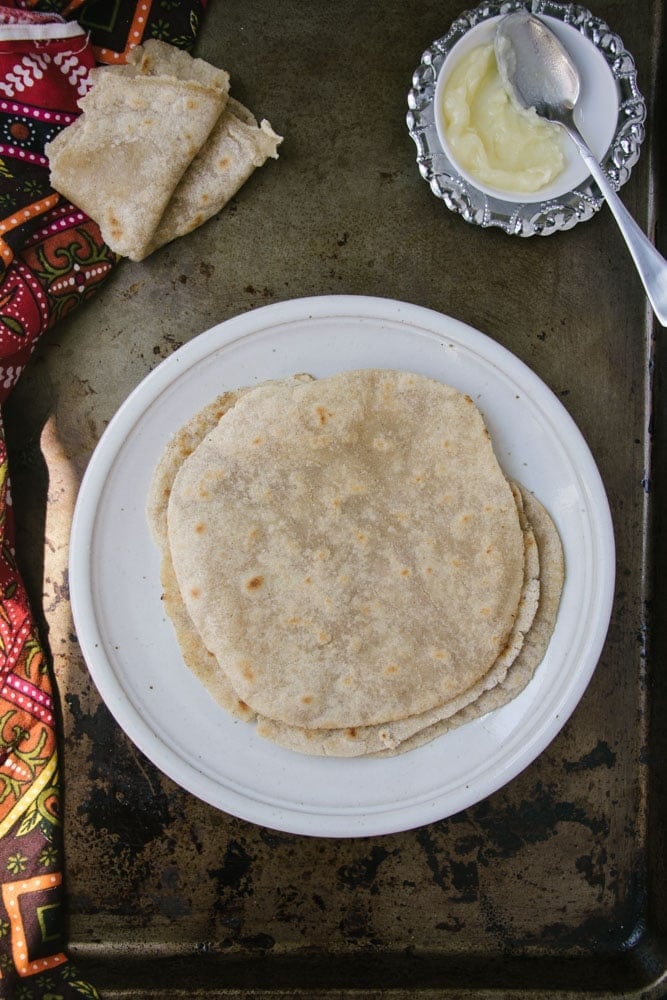
Want to save this post?
Enter your email below and get it sent straight to your inbox. Plus, get recipes & tips every week!
“Thank you for making my world a better place! I’ve tried gluten free rotis before but none of the recipes were as good as yours so I had given up. Thank you for coming up with this recipe! I feel so much joy that I can eat delicious rotis now! : )”
Virginia
May is Celiac Disease Awareness Month!
Coincidentally, last May, we became ‘aware’ that my husband had celiac disease.
This meant some changes for us as a family.
There were newfound limitations when eating out. Forgoing birthday cakes became the norm. We read nutritional information like warning labels.
But here’s the biggest change we dealt with:
On a Pakistani dinner table, along with the main dish, you’ll almost always find rice or roti (sometimes both). They are staples. Essentials. You simply can’t do without them unless you’re deviating from the cuisine in some way.
This diagnoses meant half our carb sources were eliminated, leaving us with nothing but rice. If you’re familiar with South Asian cuisine, then you know that some things are just better with roti.
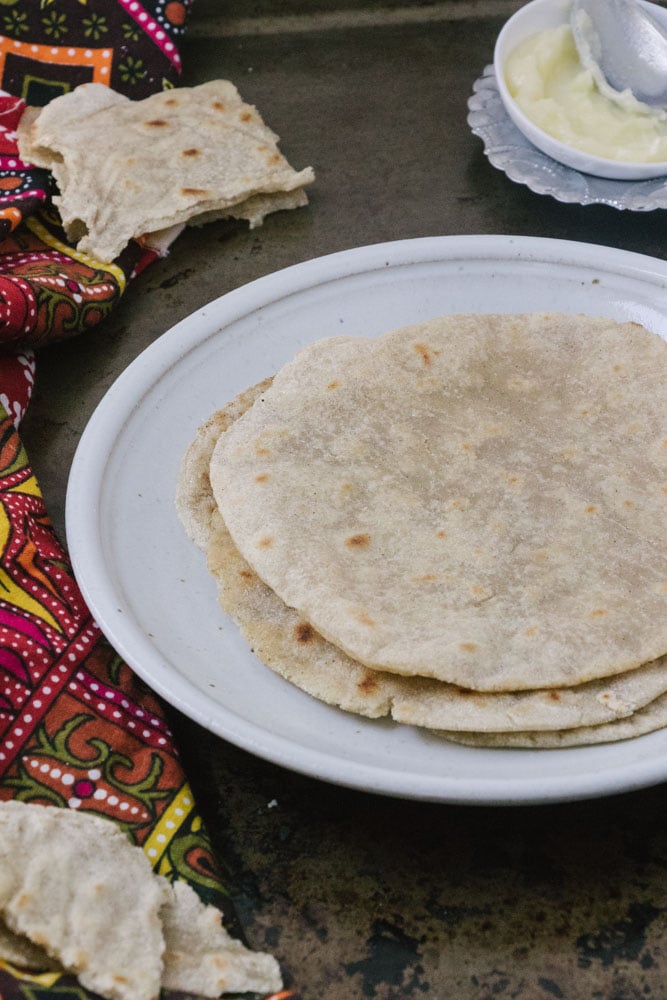
So began my journey with gluten-free roti making.
I’ve experimented making Gluten-Free Flatbreads and discovered several that I liked. Quinoa Flour Roti, for example, is protein-rich, nutritious, and quite pliable but can have a bitter aftertaste. Buckwheat Flour Roti is also packed with protein, but there’s a distinct robust taste of buckwheat.
Truth is – they may be delicious, but don’t taste like “real” rotis.
Gluten-Free Cassava and Sorghum Flour Roti
I first had the idea for this roti while I was out of town. I’ve always loved the wheat-like taste of sorghum flour, but it was usually too tough when used alone. So I thought to combine it with the more pliable, mild-tasting cassava flour.
Trust me when I say I stayed up that night thinking about this combination and how it would taste so much like real rotis.
My theory proved true. After a few experiments upon my return, this roti came out even better than I had imagined.
I did a taste test on my father-in-law, and he couldn’t tell which one was real roti and which was gluten-free. Of course, the texture is different, as always with gluten-free flours. But the taste…you won’t believe it’s gluten-free!
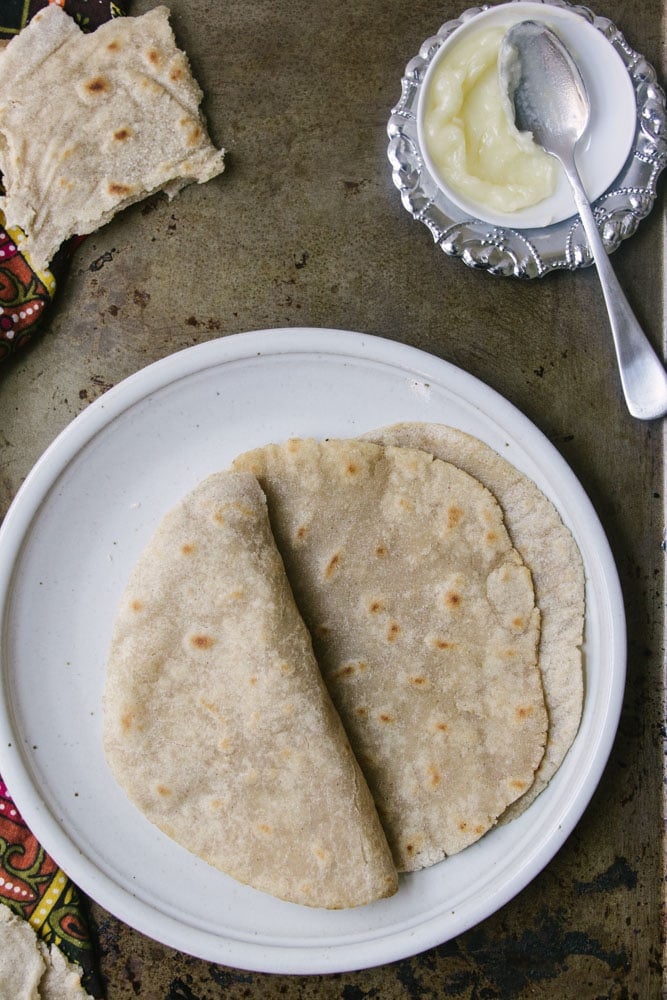
Sorghum flour (called jowar in Pakistan and India) contains protein, iron, and fiber. Cassava flour is low in calories and high in vitamin C. Unlike Tapioca starch, which is the bleached and extracted starch of the cassava root, cassava flour is made from the entire root. So this roti is a healthy day-to-day alternative for anyone seeking a new roti recipe.
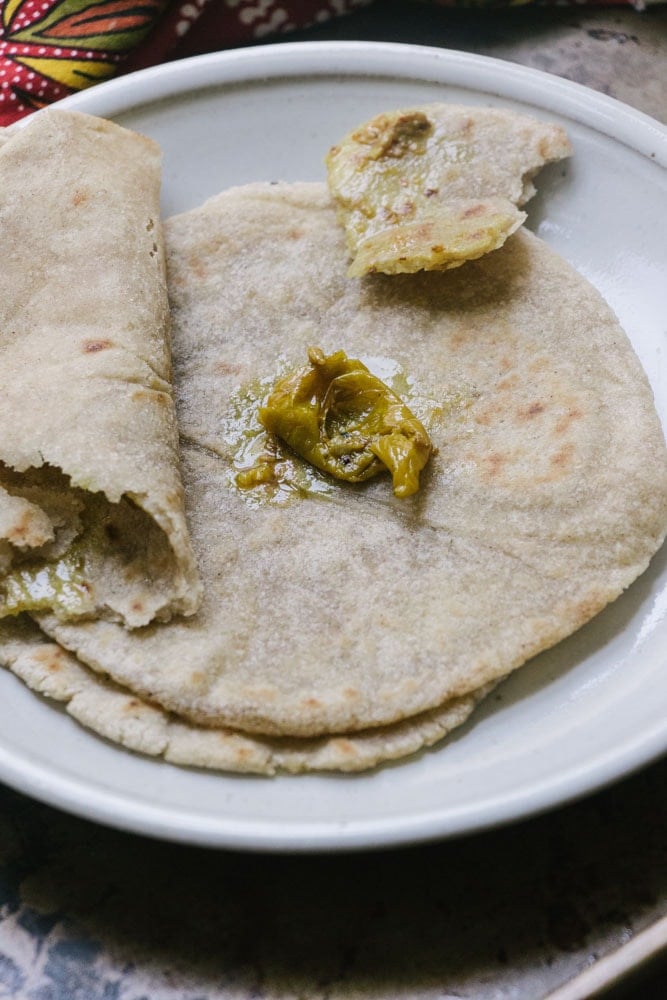
Pictured here with Achaar (South Asian mixed pickle)[/caption]
So there you have it, friends! My newest and favorite recipe for gluten-free roti. If you try it, be sure to let me know!
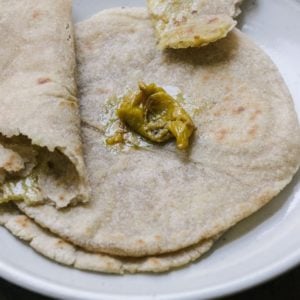
‘I Can’t Believe it’s Gluten-Free’ Cassava and Sorghum Flour Roti
Ingredients
- 2/3 cup cassava flour
- 1/3 cup sorghum flour
- 1 tbsp olive oil
- 1/8 tsp heaped salt
- ½ cup + 2 tbsp warm water
- ghee or butter for brushing
Instructions
- In a medium bowl, combine the flours, olive oil, and salt. Add the warm water, a little at a time, while continuing to mix the flour with your hands. Make sure the liquid is well absorbed before adding more. Mix and knead until a soft and elastic dough forms. You do not need to knead this dough excessively as you would for traditional rotis. Cover and let the dough rest for 30-40 minutes.
- Heat a tava, griddle or non-stick (preferably cast iron) skillet to medium-high heat, depending on your stove. You may need to lower the heat after you start making the rotis.
- Divide the dough into 4 pieces and roll between your hands to form each into a somewhat flat ball. Then place the dough between two pieces of parchment paper and roll out with a rolling pin. In between rolling, remove the top parchment and flatten with your hands. Be careful not to apply too much pressure to the rotis while rolling them out. You do not want them too thin.
- Remove the top paper and gently turn out to your hand and place on the hot skillet. Let it cook for about a minute or until the bottom sets, then flip with a large spatula and smear it with a bit of ghee or butter. Let this cook again for about a minute and then flip again, adding more oil or butter, if desired. Flip a couple more times, while pressing gently with the spatula, until the roti is completely cooked. Cover with a cloth and serve immediately.
Notes
- These rotis puff up in places but not entirely.
- I have found it to be easier to roll these out between parchment paper versus dusting them and rolling out as I do for other gluten-free flatbread recipes.
- These may be stored in an airtight container or resealable plastic bag for 24-48 hours. Reheat in the microwave or skillet.



69 Comments on “‘I Can’t Believe it’s Gluten-Free’ Cassava and Sorghum Flour Roti (Chapati)”
Can you freeze these rotis?
Thanks
Hi Tasneem, I haven’t freezing these but I have tried freezing regular rotis & parathas. The best way is to roll them out and then freeze in an airtight bag in between sheets of parchment paper. Hope that helps!
Can’t wait to try this recipe!
I was looking for specifically sorghum flour with cassava combo roti & found it اَلْحَمْدُلِلّهِ .
I want to know if these can be made in advance & frozen to be cooked when needed or cooked & frozen & reheated.
Any suggestions as to what would be the best in terms of results.
Thank you 💕
Hi Ummali, I haven’t tried freezing it but I think it could work if frozen between parchment in a large airtight container. I think you shouldn’t let it thaw but cook it directly from frozen. Again, I haven’t tried so let me know if it works for you! Also, if you’d like to make it easier to work with, maybe try adding psyllium husk as some of the other readers have mentioned.
Used good quality cassava floour and sorghum. Followed recipe exactly, adding water bit by bit and letting rest adequately. Unworkable dough, sticks to parchment; tried with very small disk for taste testing, no puffing, very acrid taste.
So sorry about that, Yves! Working with GF roti dough is definitely not the easiest. Based on your description, the dough seems to be on the wet side. You could try adding more flour to make it easier to work with. I’ll be trying this recipe with psyllium husk and maybe that’ll make it even easier to handle.
Can these be frozen? Or rather, can any/all of your roti recipes be frozen? I’m not celiac but have had to cut out so many things to figure out what is going on health wise. Been craving rotis and parathas to no end, even though I hardly eat them regularly!
Thank you! This was my most successful gluten free bread attempt. I still made a small roti and it was super oddly shaped but atleast it didn’t crumble the way it has before. The parchment paper technique is great. Next time I’m going to tape up the bottom parchment with some painters tape to the counter so everything does not move as much. The roti tasted very good and i can finally see myself trying a gluten free diet and giving my gut some relief. Thank you so much!!
So wonderful to hear that, Nisha. I’m delighted it worked out for you and thanks for sharing the tip. I hope you try the naan as well!
Very good! Made with curry dinner! I may have over cooked because they were alittle more stuff and less pliable but still tasted awesome. Will try another commenters recommendation of psyllium husk next time!
Thank you, Terra. Happy you liked the taste. I’ll update when I try it with psyllium husk as well!
Thank you so much for this recipe, I’ve been looking for a gluten free flat bread recipe like this!!!. I’m so happy finally found the perfect one, especially there’s a lot of those flours in Indonesia.
So happy to hear that. Thanks so much for sharing, Nisa!
Hi Izzah, good to find your blog… will try this… but have you tried adding ispaghol to gf-rotis? it works as binding agent as gluten does to normal roti… most commercial products like gf-breads use it in some form…
Thank you, Uzma. Yes, I’ve tried ispaghol (psyllium husk) and yes it does bind and make it more pliable! Feel free to play around with it with this roti and others!
All this made was a mess. I threw it in the trash and made rice. I will never attempt this recipe, or any other “roti” recipe ever again.
So sorry to hear that, Gianni! GF roti is not easy to shape and prepare, even for me and I routinely make regular rotis…so please don’t give up. If you’d like a GF flatbread that’s easier to handle, try my GF naan!
Don’t give up, takes a few tries to do anything new
Yes, rotis, and especially GF rotis are no doubt something you get better at with practice!
I followed the recipe exactly and it all looked good until the rolling between the grease-proof paper.
The roti stuck to the bottom sheet and it was difficult to lever off without breaking up the roti. Advice welcome. Thanks.
Hi Roger. This may help: After rolling it out in between parchment, remove the top paper and place the roti on the pan, then quickly removing the other side of the parchment paper. I’ll be working on an easier to work with roti recipe. In the meantime, you can’t go wrong with naan!